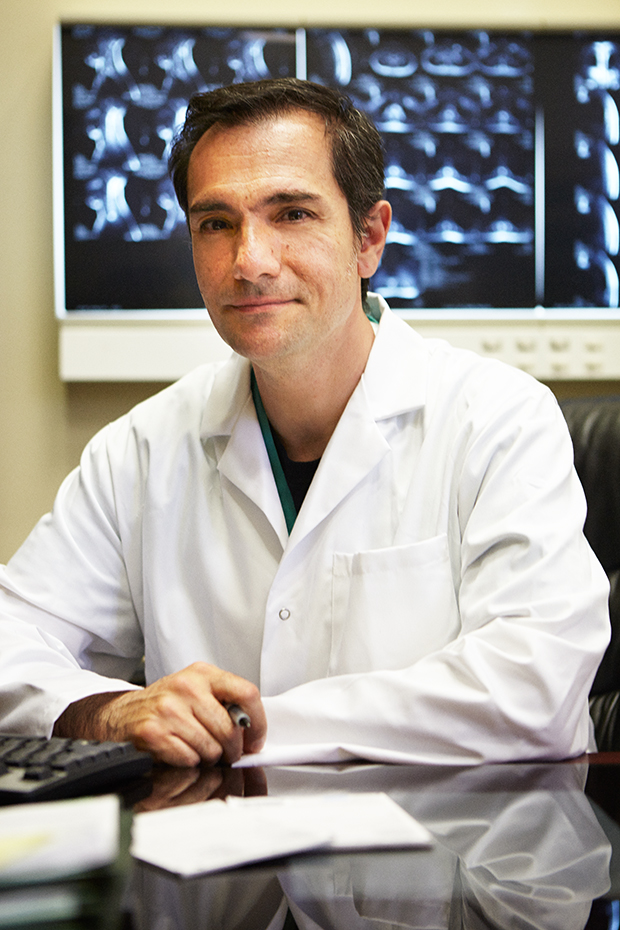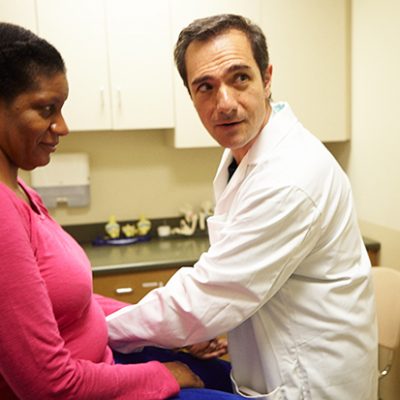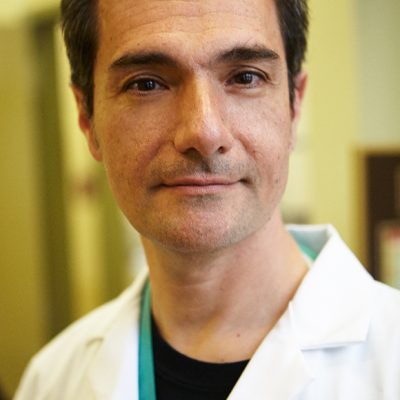
How spine specialists at New York Methodist Hospital remain in the vanguard of this critical area of care
Photos By Jon Gordon
The spine’s vertebrae wind their way from the base of the skull to the small of the back, playing a vital role in overall health and well being, providing the ability to sit, stand, walk, and move so effortlessly that we take it for granted. But for some, the spine is a source of pain–from illness, deformity or traumatic injury. That is when the spine specialists at New York Methodist Hospital can help.
As integral as the spine is to the body, NYM’s team of spine surgeons is key to the Hospital’s Institute for Orthopedic Medicine and Surgery. One of the key members of the team, Andrew Merola, M.D., has worked on the spines of countless patients, transforming their lives and increasing their ability to move freely. An orthopedic reconstructive spine surgeon, Dr. Merola joined the hospital in 1999. He developed his expertise during a fellowship in reconstructive spinal surgery at the University of Colorado, and is currently a fellow of the Scoliosis Research Society and the American Academy of Orthopedic Surgeons.
An early interest in pediatric spinal issues, which later evolved to include spinal reconstruction in adults, is what led Dr. Merola to select this area of medical practice. “I was interested in helping children with spinal deformities,” said Dr. Merola. He explained that approximately seven to eight percent of the population has some type of spinal deformity, but just one percent actually needs surgery.
Dr. Merola explores all possible non-surgical options before even entertaining the idea of surgery. In some cases, like mild scoliosis (abnormal curvature of the spine), external bracing may be recommended. The brace supports the spine and keeps it from moving, thus allowing the spine to heal, in the case of injury, or straighten, if the curve is congenital. For patients experiencing pain and/or numbness from a herniated disk, a combination of specific nerve pain medication, cortisone and physical therapy can usually relieve symptoms.
However, if a condition threatens to cause greater deformities over time or to affect healthy functioning of other parts of the body, or if it causes considerable, consistent pain, surgery may become necessary course of action. For example, severe scoliosis can impinge on the chest space surrounding the lungs, preventing the lungs from fully expanding, thus inviting additional cardiopulmonary issues.
“In such cases of severe scoliosis, a procedure known as spinal fusion surgery might be recommended,” said Dr. Merola. “Spinal fusion surgery involves removing the joints between the curving vertebrae. A bone graft is then placed in each joint space that has been removed. Over the course of four to six months, the graft incorporates into the vertebral bone, and the portion of the spine that was operated on heals into a solid block of bone that cannot bend, thus eliminating further curvature.”
The discomfort of a condition called spinal stenosis—narrowing of the spaces in the spine that results in irritation to the spinal cord and surrounding nerves—can be quite painful and cause numbness and muscle weakness. Anti-inflammatory and pain relief medication as well as physical therapy can often be prescribed to treat the pain, but sometimes, a surgical procedure called a laminectomy is necessary.
“With this procedure, we remove the rear portion of the vertebrae (the lamina), opening up the space and removing the source of irritation,” Dr. Merola explained. “We then fuse the spine around the surrounding vertebra to ensure that there is enough remaining support.”
Recent advances have allowed spinal fusion surgery to be performed much less invasively than was previously the case, using x-rays to guide instruments through small incisions that result in faster recovery, less tissue damage, and reduced pain for patients.
Spinal implant hardware, such as that used in spinal fusion surgery or when the spine needs to be correctively realigned, has also advanced in design and functionality. “Spinal implants are now made from materials that are compatible with MRI (magnetic resonance imaging). In addition, the advanced design of many implants incorporates some of the functions of external braces previously used in the recovery process, making it easier for patients to get out of bed and start moving again, which aids in healing,” said Dr. Merola.
Beyond the technology and skill of NYM’s healthcare staff, Dr. Merola credits teamwork with setting NYM apart.
“We have a small, dedicated team of professionals that works with patients having spinal surgery in the operating room and continues with them through to rehabilitation. There is a dedicated floor for patients recovering from orthopedic surgery, and nurses and rehabilitation specialists who are trained to handle issues specific to these patients. Although it’s a big hospital, it has a small team approach to ensure excellent patient care,” said Dr. Merola.
Dr. Merola’s associates, spinal surgeons Franco Cerabona, M.D., and Carl Paulino, M.D., work closely with him on many cases. With procedures that require instruments and work that is very close to the spinal cord, for instance removal of a bone tumor in the spinal cavity, a neurosurgeon from NYM’s Department of Neurosciences will also operate along with the spine surgeon to ensure the best outcome.
“I recently worked on a case where an osteoid osteoma (a tumor in the bone) had developed in a vertebra in the lower back, close to the spinal cord,” recalled Dr. Paulino. “I worked closely with neurosurgeon Nicholas Post, M.D., to actually maneuver in the spinal cavity to remove the tumor.”
“Having such a broad array of resources and specialists is one of the benefits at New York Methodist,” added Henry Tischler, M.D., chief of orthopedic surgery at NYM.
“The first and foremost priority for me is the welfare of my patients. Just as they are unique individuals, so are their cases,” concluded Dr. Merola. “The reason I’ve been at New York Methodist for so many years is that I know that I have the colleagues, facilities, and support I need, and that my patients need, to thrive.”
The Institute for Orthopedic Medicine and Surgery at New York Methodist Hospital
1.866.ORTHO.11
New York Methodist Hospital / 506 Sixth St., / 718.780.3000





